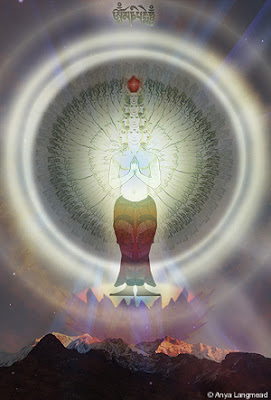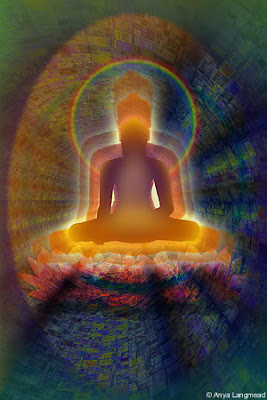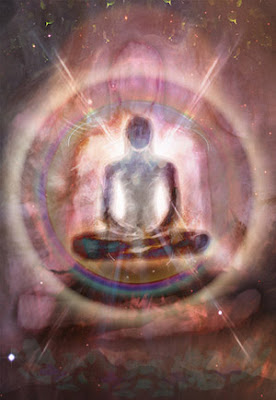Jun 21, 2016
New book on Human Computer Confluence - FREE PDF!
Two good news for Positive Technology followers.
1) Our new book on Human Computer Confluence is out!
2) It can be downloaded for free here

Human-computer confluence refers to an invisible, implicit, embodied or even implanted interaction between humans and system components. New classes of user interfaces are emerging that make use of several sensors and are able to adapt their physical properties to the current situational context of users.
A key aspect of human-computer confluence is its potential for transforming human experience in the sense of bending, breaking and blending the barriers between the real, the virtual and the augmented, to allow users to experience their body and their world in new ways. Research on Presence, Embodiment and Brain-Computer Interface is already exploring these boundaries and asking questions such as: Can we seamlessly move between the virtual and the real? Can we assimilate fundamentally new senses through confluence?
The aim of this book is to explore the boundaries and intersections of the multidisciplinary field of HCC and discuss its potential applications in different domains, including healthcare, education, training and even arts.
DOWNLOAD THE FULL BOOK HERE AS OPEN ACCESS
Please cite as follows:
Andrea Gaggioli, Alois Ferscha, Giuseppe Riva, Stephen Dunne, Isabell Viaud-Delmon (2016). Human computer confluence: transforming human experience through symbiotic technologies. Warsaw: De Gruyter. ISBN 9783110471120.
09:53 Posted in AI & robotics, Augmented/mixed reality, Biofeedback & neurofeedback, Blue sky, Brain training & cognitive enhancement, Brain-computer interface, Cognitive Informatics, Cyberart, Cybertherapy, Emotional computing, Enactive interfaces, Future interfaces, ICT and complexity, Neurotechnology & neuroinformatics, Positive Technology events, Research tools, Self-Tracking, Serious games, Technology & spirituality, Telepresence & virtual presence, Virtual worlds, Wearable & mobile | Permalink
Jul 29, 2014
1st Place Video at 2014 Princeton University Art of Science competition
And the winner is... Sabine Petry and co-workers, Petry Lab, Princeton Department of Molecular Biology.
Description: Microtubules are hollow filaments that serve as the skeleton of the cell. They were thought to grow linearly, but this movie shows that they can branch: microtubules (red with growing tips in green) grow off the wall of existing microtubules. In addition, microtubules are moved along the glass surface by molecular motors. Microtubule branching amplifies the microtubules while preserving their polarity and explains how microtubules can cause the mitotic spindle of a dividing cell to reliably segregate chromosomes (Petry et al., Cell 2013).
Scale: A microtubule has a diameter of 25 nanometer and is the largest cytosekeletal filament in the cell.
More on the Princeton University Art of Science competition: http://artofsci.princeton.edu/
23:01 Posted in Cyberart, Research tools | Permalink | Comments (0)
Apr 15, 2014
A sweet, sad stop-motion film made with 3-D printing
Via Wired
London-based creative agency DBLG shows the way with “Bears on Stairs,” a short clip that combines a 3-D printed hero with traditional stop-motion animation to charming effect. The ursine epic has a 2-second run time and took four weeks to complete, making it about as efficient as your average Michael Bay production, by my rough calculations. The lumbering action took 50 printed models in all.
BEARS ON STAIRS from DBLG on Vimeo.
22:32 Posted in Cyberart | Permalink | Comments (0)
Mar 09, 2014
Shugo Tokumaru "Katachi"
14:29 Posted in Creativity and computers, Cyberart | Permalink | Comments (0)
Mar 03, 2014
By licking these electric ice cream cones, you can make music
From Wired
Ice cream can be the reward after a successful little league game, a consolation after a bad breakup, or, in the hands of gourmet geeks, a sweet musical instrument. Designers Carla Diana and Emilie Baltz recently whipped up a musical performance where a quartet of players jammed using just a quart of vanilla ice cream and some high-tech cones

00:07 Posted in Creativity and computers, Cyberart, Future interfaces | Permalink | Comments (0)
Feb 08, 2014
An Inuit/Eskimo family in the Arctic 1959
The barren life of an Inuit family and their children in Iqaluit, Nunavut, Arctic Canada more than fifty years ago.
Why do I blog this? Just because I liked it.
21:33 Posted in Cyberart | Permalink | Comments (0)
Nov 03, 2013
The poetry of Everyday Objects
Artist Javier Pérez turns everyday objects into whimsical illustrations. Here are some of my favourites. Discover more on his Instagram account.



23:56 Posted in Cyberart | Permalink | Comments (0)
Jul 23, 2013
Augmented Reality - Projection Mapping
22:50 Posted in Augmented/mixed reality, Blue sky, Cyberart | Permalink | Comments (0)
Dec 27, 2010
Post-apocalyptic Tokyo scenery
fantastic photo manipulations by Tokyogenso. See more here
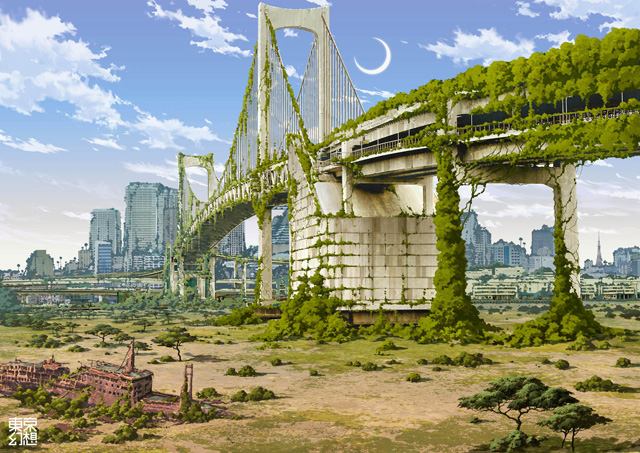
17:30 Posted in Blue sky, Creativity and computers, Cyberart | Permalink | Comments (0)
Aug 26, 2010
Heart Chamber Orchestra
The Heart Chamber Orchestra consists of classical musicians who use their heartbeats to control a computer composition and visualization environment. To my best knowledge, this is the first example of "group biofeedback".
The musicians are equipped with ECG (electrocardiogram) sensors. A computer monitors and analyzes the state of these 12 hearts in real time. The acquired information is used to compose a musical score with the aid of computer software. It is a living score dependent on the state of the hearts.
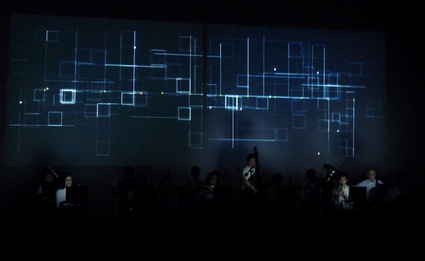
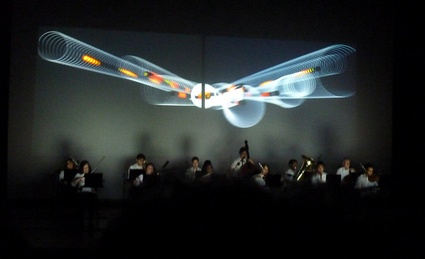
While the musicians are playing, their heartbeats influence and change the composition and vice versa. The musicians and the electronic composition are linked via the hearts in a circular motion, a feedback structure. The emerging music evolves entirely during the performance.
The resulting music is the expression of this process and of an organism forming itself from the circular interplay of the individual musicians and the machine.
The sensor network consists of 12 individual sensors; each one is fitted onto the body of a musician. A computer receives the heartbeat data. Software analyzes the data and generates via different algorithms the real-time musical score for the musicians, the electronic sounds and the computer graphic visualization
Below is a video documentation from the Heart Chamber Orchestra performance on the 28th of March 2010 at Kiasma Theatre at Pixelache Festival in Helsinki, Finland.
20:02 Posted in Biofeedback & neurofeedback, Creativity and computers, Cyberart | Permalink | Comments (0) | Tags: biofeedback, heart chamber orchestra, creativity
May 18, 2010
Harvest
Harvest (2009) is a new art piece for the new instrument terrafon, traditional ensemble and cropland - by Olle Cornéer and Martin Lübcke.
In the first performance Alunda Church Choir, conducted by Cantor Jan Hällgren, played the soil of northern Uppland (in Sweden) on terrafon. Terrafon is a large agricultural version of the horn gramophone, amplifying the sounds in the track it ploughs.
Watch the performance here:
http://vimeo.com/5075042
Read more here:
http://corneerlubcke.com/
Download some other pics here:
http://ollecorneer.com/art/harvest/
Dec 06, 2009
Avatar: Can't wait any longer
I just can not wait for the new James Cameron's movie Avatar...
The iPhone Orchestra
The Stanford Mobile Phone Orchestra (MoPhO) is a new repertoire-based ensemble using mobile phones as musical instrument. MoPhO's interactive musical works take advantage of the unique technological capabilities of today's hardware and software, transforming multi-touch screens, built-in accelerometers, built-in microphones, GPS, data networks, and computation into powerful and yet mobile chamber meta-instruments.
The researcher behind the idea, Ge Wang, believes cell phones are becoming so powerful that we “cannot ignore them anymore as platforms for creativity. . . . It levels the playing ground in some ways, because everyone has a cell phone.”
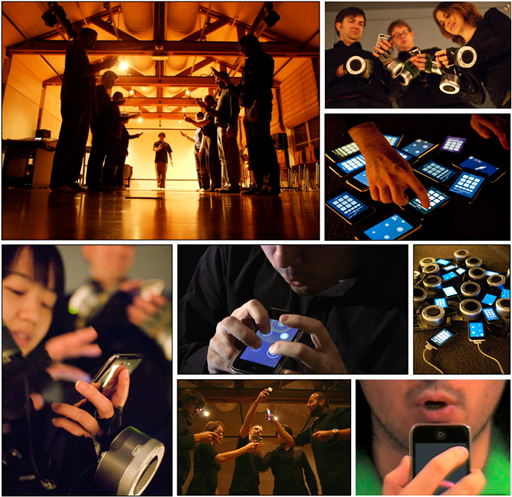
The Stanford Mobile Phone Orchestra’s performance on December 3 at Palo Alto (CA) used an Apple iPhones amplified by speakers attached to small fingerless gloves. Here is a video of the concert.
13:34 Posted in Creativity and computers, Cyberart, Positive Technology events, Wearable & mobile | Permalink | Comments (0) | Tags: iphone, cybermusic, cybersound, orchestra, stanford, mobile phone, digital creativity
Jul 15, 2009
Solar
Solar - by Rejane Cantoni and Leonardo Crescenti
(under development)
Solar is a robotic installation, immersive and interactive, designed to simulate qualities and measures of solar light in relation to man-space time. The interactor can agency the machine in two ways: he can control his geographic position with his feet and/or he can speak with it. Agencying via positioning make it possible for the interactor to inform his geographic position to a data bank. One possible example of this type of user-system interaction could be: You enter the machine – a black rotunda of 6.30 in diameter x 3.50 high. In the center, there is a movable platform. Upon stepping on it, the gravitational force of the body is interpreted by the system that, in function of the relative latitude and longitude, alters the original setup.
For example, when you step in front of the platform, the system advances to the north, i.e., it produces, on the plasma wall, visual feedbacks that appear as modifications in the latitudes of the imaginary lines which, in this case, advance from Equador to the North Polar Circle (see on video an example of navigating in the inverse direction, south). Agencying via voice command, on the other hand, makes it possible for the interactor to particularize a date and a moment of an event. For example: when the interactor says “August 03 at 3 p.m.”, the system associates to this command the information to his relative position, which makes it possible to simulate the solar light intensity relative to the space-time solicited. To the eyes of the outside observer, without movement or without the interactor’s voice command, time, in this machine, stops.

Rejane Cantoni and Leonardo Crescenti
10:47 Posted in Cyberart | Permalink | Comments (0) | Tags: cyberart, platform, projection screen, light system, voice recognition
Jul 05, 2009
Magnetic Liquid
Nice video of magnetic liquid (ferrofluids) created by Sachiko Kodama and Minako Takeno that reminds me to some sort of artificial life
12:47 Posted in Cyberart | Permalink | Comments (0) | Tags: cyberart
Apr 16, 2009
Turing Tables to understand earthquakes
Earthquakes are complex natural phenomena that are difficult to predict but also to understand.
German artist Franz John created an online installation - Turing Tables - that makes earthquakes easier to fathom while reminding us how alive the Earth is.
Inspired to the work of matematician Alan Turing, The Turing Tables gathers data from a multitude of small earthquake sensors (called “fingers”) stationed around the globe into a real-time, online installation before converting the data into image and sound. Green-and-black moving wallpaper—composed of numeric data and the locations and times at which the readings are taken—fills the room, along with a grating yet melodic soundtrack courtesy of Oakland-based sound artist Ed Osborn.

13:05 Posted in Cyberart, Information visualization | Permalink | Comments (0) | Tags: cyberart, information visualization
Kinetic Wave Sculptures
Via Idearium
Californian artist Reuben Margolin creates complex kinetic sculptures. His artworks are made using different materials - salvaged wood, metal, cardboard, and other recycled stuff - with sculptures ranging from tiny to looming, motorized to hand-cranked. Elegant and hypnotic.
.
01:59 Posted in Cyberart | Permalink | Comments (0) | Tags: cyberart
Oct 23, 2008
DXARTS - Professorship in Hybrid Arts Practice
DXARTS | PROFESSORSHIP in HYBRID ARTS PRACTICE
www.dxarts.washington.edu
Pending budgetary approval, The Center for Digital Arts and Experimental Media (DXARTS) at the University of Washington is seeking to fill a tenured or tenure track faculty position in HYBRID ARTS PRACTICE. Rank is open, and we will consider hires from Assistant to Full Professor with tenure.
Established in 2001, DXARTS is a pioneering experimental arts unit with exciting undergraduate and doctoral degree programs. DXARTS brings together faculty from Art, Music, Dance, Computer Science, Electrical Engineering, Physics, Biology, History of Ideas, and Design in a hybrid research environment dedicated to the invention and exploration of new forms of digital and experimental art.
The successful candidate for this position should be an artist hybrid engaged in advanced generative digital and experimental arts practice, as well as integrating research on the epistemological and ontological questions raised by the broader art, science and technology discipline.
Applicants for this position should at minimum hold a Masters Degree or equivalent experience and present a well documented career of significant creative accomplishments. The ideal candidate will have a strong and deeply integrated background blended across numerous creative, interpretive and technical fields such as art, music, film, design, dance, theater, computer science, cognitive science, engineering, history, psychology, and philosophy.
Applicants should be prepared to pursue innovative art and technology research, as well as teach introductory and advanced courses in comprehensive studio practice, and the history and analysis of digital and experimental arts.
Applications must include: CV, artist statement, statement on pedagogy, and a cohesive portfolio of professional creative work. Support materials must include three references with phone numbers, mail and e-mail addresses, samples of previous course design and recent student work. Portfolio work should be formatted for viewing on any platform. Please include a SASE for return of materials. Also inform us if you will be attending the CAA conference in Los Angeles, CA.
Application materials should be addressed to: Chair, HYBRID ARTS PRACTICE Search Committee, DXARTS, 207 Raitt Hall, Box 353414, University of Washington, Seattle, Washington 98195-3414. Priority will be given to applications received before January 15, 2009. The University of Washington is building a culturally diverse faculty, and strongly encourages applications from female and minority candidates. The University is an Equal Opportunity, Affirmative Action employer.
A competitive recruitment and selection process is being conducted and if a U.S. worker is not selected pursuant to this process, an application for Alien Employment Certification may be filed on behalf of an alien to fill this job opportunity. Any person may provide documentary evidence bearing on the application (such as information on available workers, wages, working terms and conditions, or other pertinent information) to either:
Employment Security Department
AEC Unit
P.O. Box 9046
Olympia, WA 98507-9046
OR
Employment & Training Administration
Region VI, U.S. Department of Labor
Certifying Officer
P.O.Box 193767
San Francisco, CA 94119-3767
09:29 Posted in Cyberart, Research institutions & funding opportunities | Permalink | Comments (0) | Tags: cyberart
Mar 13, 2008
Electrohype 2008
Electrohype 2008 will present works by 5 - 8 artists or artist groups. To give the exhibition a broad perspective we are looking for Nordic as well as international artists. Electrohype has since the start in 1999 focused on what we choose to call computer based art. Art that runs of computers and utilizes the capacity of the computer to mix various media, allow interaction with the audience, or machines interacting with each others etc. in other words art that can not be transferred to “traditional” linear media. This might seem as a narrow approach but we have discovered that it gives us a better focus on a genre that in no way is narrow.
We are not looking for “straight” video art (even if it is edited on a computer) or still images rendered on computers and other material that refers to more “traditional” media forms. Forms were the traditional tools have been replaced with computers and software.
Curators for the biennial are Anna Kindvall and Lars Gustav Midbxe.
Practical: You can submit with our online form or download the application form as PDF-file. You have to use one of these two forms to submit to our call. This can be found on this address. NOTE: Please do NOT send documentation material as attachments via e-mail. Put your material online and send us the download URL or ftp address, or send us a CD or similar in the mail. Do NOT send 8 pages CVs and only complement with enclosures if it is necessary. Please read the form and follow the guidelines. We receive a large amount of proposals and all of them are reviewed closely. To be able to do this we ask you to follow the structure in the application form and the topics mentioned above.
Financial: Due to a limited budget we will encourage everyone submitting material to look for possibilities for local funding to help cover costs for transport, travel and rent of technical equipment. This is not a requirement but a request; external funding can help us during the financial planning. The quality of the artwork will always be the determining element.
Electrohype covers all expenses, within reasonable limits, and also pays an artist honorarium to participating artists. Electrohype does not support development and production of unfinished artworks.
In previous exhibitions we have managed to keep a high level both in artistic content and exhibition design, even on a modest budget. It is therefore very important for us to avoid unpleasant surprises, so please keep this in mind when filling out the various posts in the form, especially when it comes to technical requirements, transport weight etc.
18:52 Posted in Cyberart | Permalink | Comments (0) | Tags: cyberart
Mar 10, 2008
The art of Anya Langmead
00:41 Posted in Cyberart | Permalink | Comments (0) | Tags: cyberart










